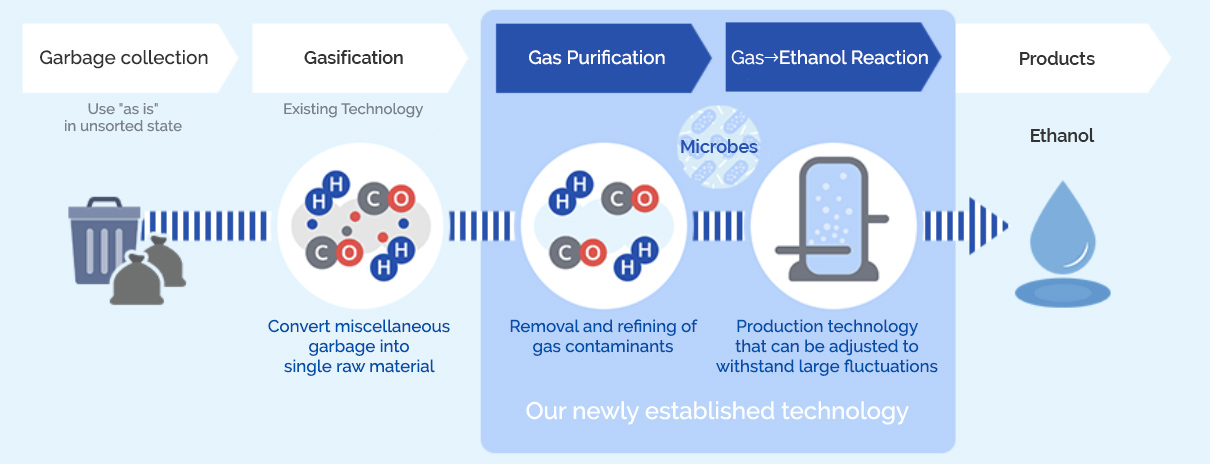History
SEKISUI INC., the predecessor of SEKISUI CHEMICAL CO., LTD.,
was founded on March 3, 1947 by the younger generation of
Nicchitsu Konzern – the then core company of the general chemical manufacturers in Japan.
-
1947
Established SEKISUI INC. with the goal of running a general plastic business.

Founding members -
1948
Opened a plant in Nara ( – 1957),
with automatic injection molding giving rise to the first plastic automatic injection molding business in JapanCompany name changed to SEKISUI CHEMICAL CO., LTD.
 【Corporate Symbol】
【Corporate Symbol】
The 3S 's from the three words of the original company name (SEKISUI Sangyo) are arranged inside a hexagonal mark (the chemical symbol for benzene) and made to resemble the Japanese character for "water"Opened a new plant in Osaka ( – 1971),
producing PVA and cellophane tape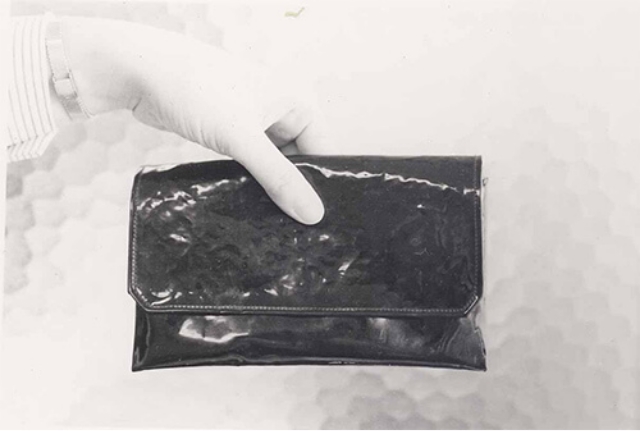
Handbag made of PVA (poval film)
Tips_1940s
The long-desired factory finally begins operation, delivering molded products made from a new material to the world
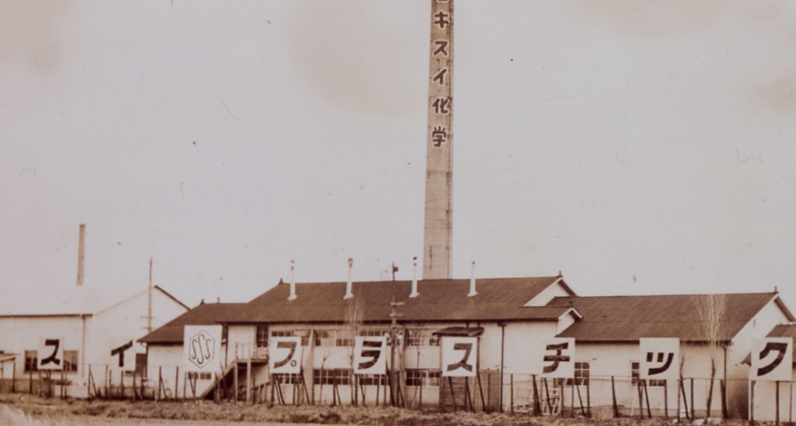
-
1950
Exhibited a trial cellophane tape product at the Osaka Hankyu Plastics Exhibition
An American magazine article hints at development.
Cellophane tape, a necessity for repairsSEKISUI began producing its famous cellophane tape from 1950 because of a small article in a magazine. Cellophane tape was used by stationed American troops to seal the envelopes they brought, and interest in this led to research into production methods.
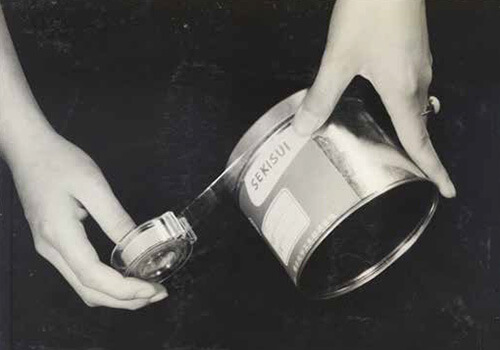
-
1952
Opened a new plant in Kyoto,
and started full scale production of ESLON Pipe, a hard PVC pipePVC pipe is born, opening up a new world of plastics
Succeeding with Japan's first PVC pipe production, the Kyoto Plant attained JIS certification for PVC pipe in July of 1954, and was designated a JIS Certified Factory in March of 1955

-
1953
Opened a new plant in Tokyo ( – 2015),
and started production of plastic molding products to become the supplier in the Kanto region.ESLON Pipe from the Tokyo Plant in the 1950s became synonymous with all PVC pipe, and was a cornerstone of the business, together with molded products. In 1955, metal mold production began.
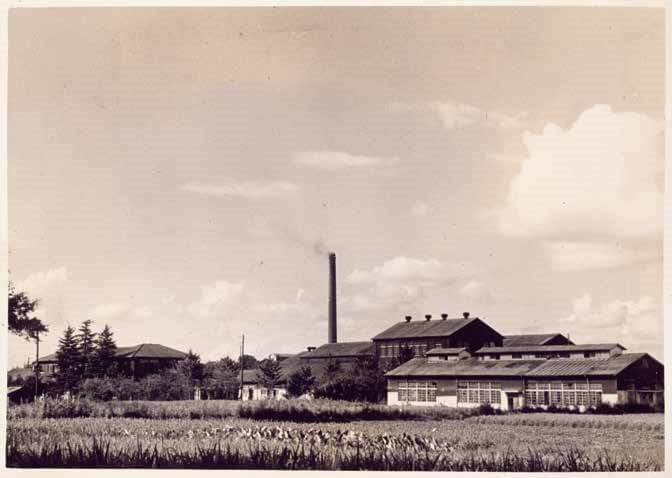
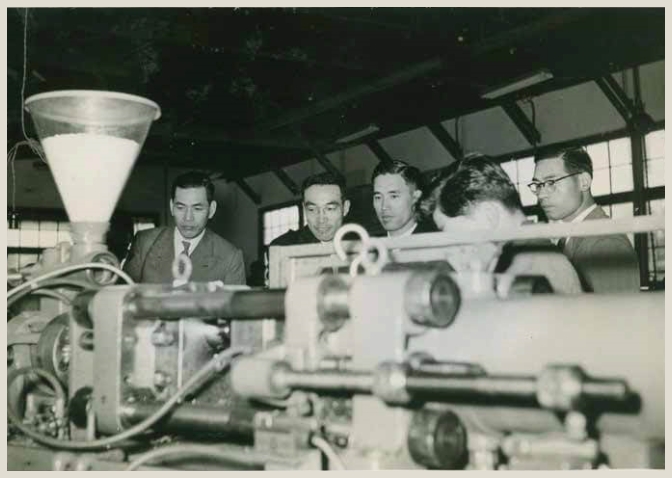
First listed on the Osaka Securities Exchange, and in 1954, first listed on the Tokyo Stock Exchange
-
1955
Succeeded in molding injection of the PVC pipe fittings that played an important role in the popularization of ESLON Pipe
Company song is established
-
1956
Developed Japan's first plastic rain gutters, ESLON Rain Gutters.
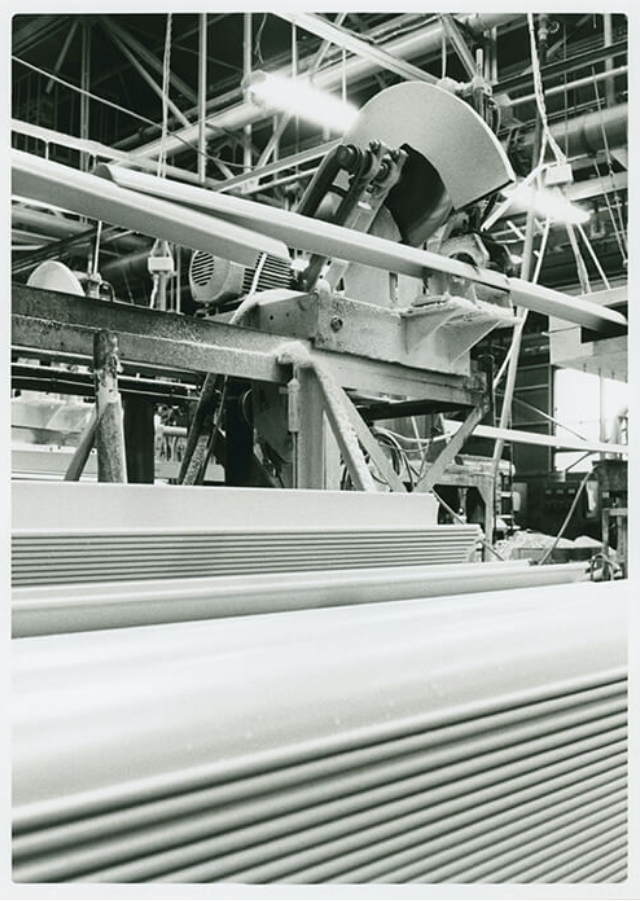
Production of rain gutters in 1956 -
1957
Opened a new plant in Nara,
becoming the largest plastic molding plant in AsiaProduct launch of Poly Buckets, buckets made from polyethylene
-
1958
Production begins for S-LEC, an interlayer film for laminated glass
-
1959
The 3S Principal is officially adopted as a corporate philosophy
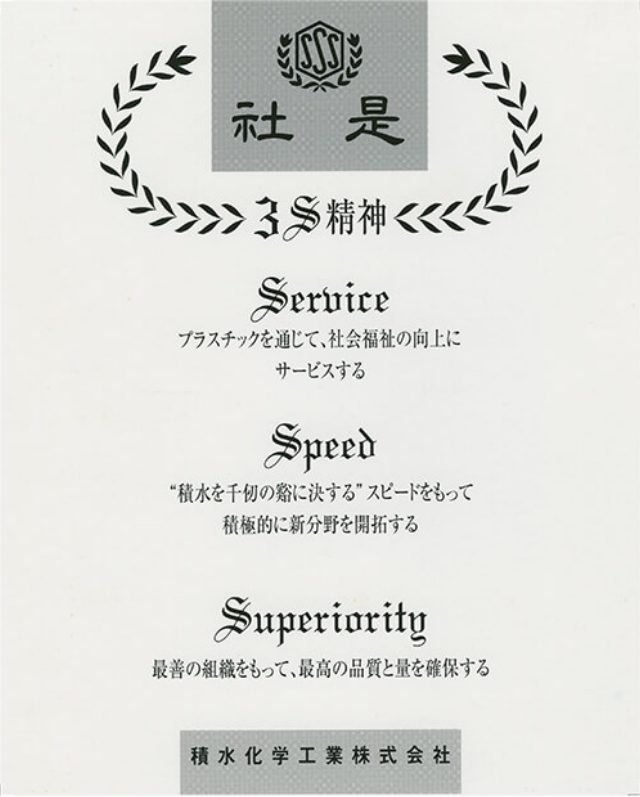
【Corporate Philosophy – the 3S Principal】
This principal hasn't changed since the company was established, but part of the principal was re-interpreted in 1992
Tips_1957
The Poly Bucket – a standard wedding gift that every bride desires!
Nowadays, you can find Poly Buckets throughout Japan, but when it was first introduced in Japan in the second half of the 1950s, it was the latest lifestyle product that was a part of every bride’s arsenal. It became popular for its usefulness and as a stylish gift.
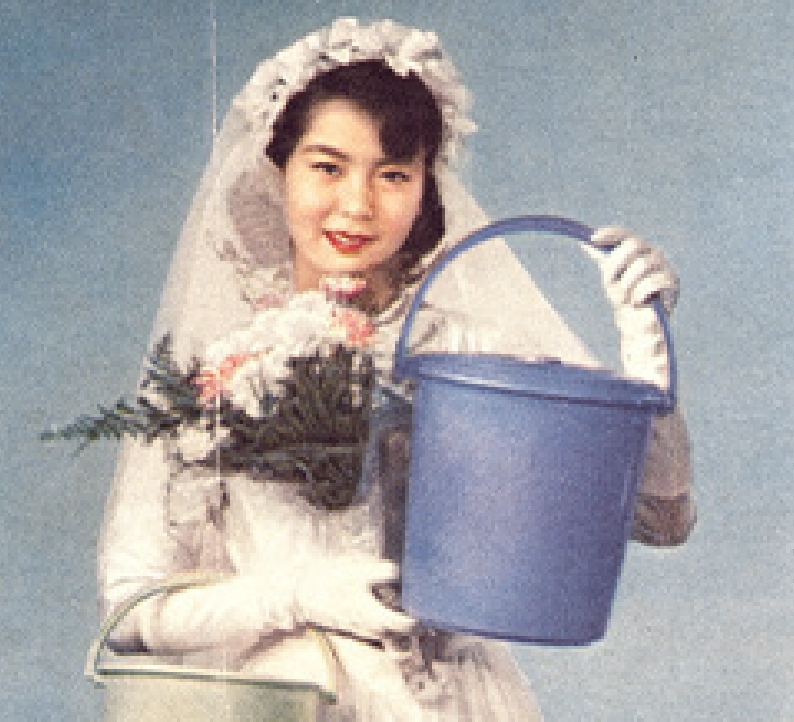
-
1960
Opened a plant in Ritto, Shiga
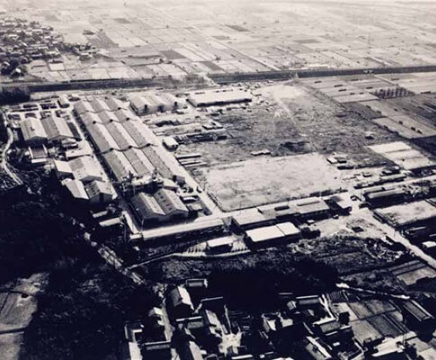
Shiga Ritto Plant in the 1960s 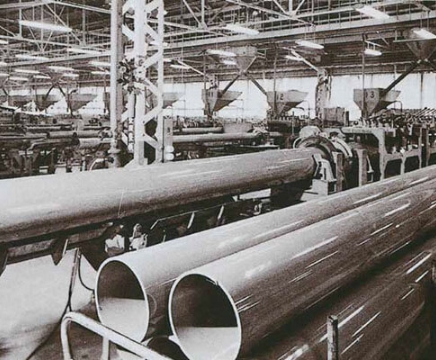
Built as the main factory for extrusion molding of PVC pipe, etc. Opened a plant in Minakuchi, Shiga
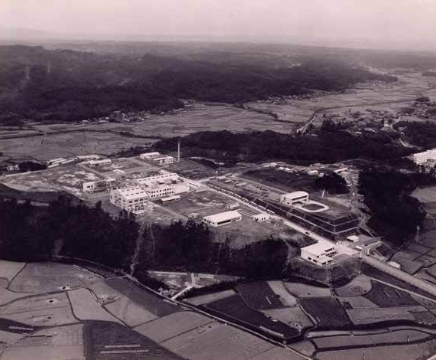
Shiga Minakuchi Plant in the 1960s The SEKISUI House Model A trial was a success, further advancing the housing business division.
In the same year, SEKISUI House Sangyo Co., Ltd. (now SEKISUI House Co., Ltd.) was spun off as a separate company.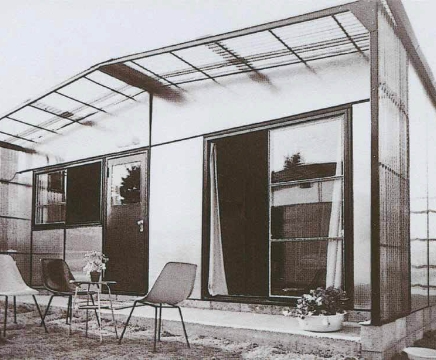
The first SEKISUI House Model A.
It was the first time light gauge steel was used as a general housing construction material. At the time, there were dreams of an all- plastic house. -
1961
Opened the Central Research Laboratory (now High Performance Plastics Company’s Research & Development Institute) in Minase, Osaka

A class at the Central Research Laboratory (now High Performance Plastics Company’s Research & Development Institute) and SEKISUI CHEMICAL Kogakuin University. The campus featured a school building, a student dorm, a gym, and other facilities. In its 5 years of operation, over 450 students studied here. -
1962
Opened a plant in Musashi
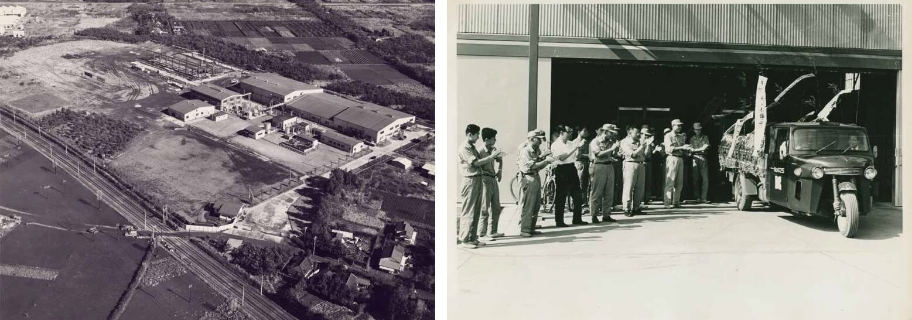
The Musashi Plant in 1962 (left) and the first shipment of tape (top) Kraft and paper tape production commenced in 1963, with polyethylene film production following in 1964, becoming a base for packaging material. The "Clean Up Our Streets” movement was started as a campaign commemorating the company's 15th anniversary, and a cleaning revolution fueled by the Poly-Pail spread throughout Japan
Tips_1962
The 15th anniversary "Clean Up Our Streets” movement begins.
A city beautification movement was developed based on a slogan: “Make Tokyo beautiful through the hands of ten million”.
This lead to the popularization of Poly-Pails. SEKISUI CHEMICAL also sought after city beautification through a revolutionary advertisement series in the 1960s based around a motto: “Bring the Olympics to beautiful Tokyo”. These sales promotion activities connected with the public, and many public organizations and ladies’ societies favorably took up the cause, leading the Poly-Pail to unprecedented success and praise as a “revolution in cleaning” from various media outlets.
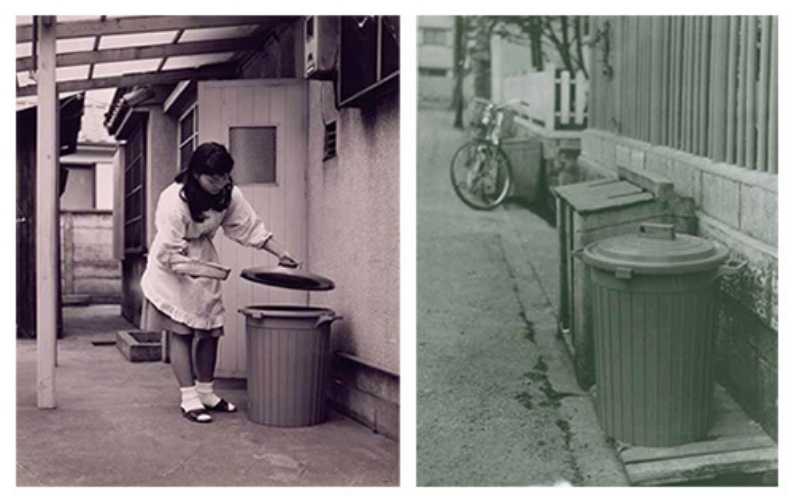
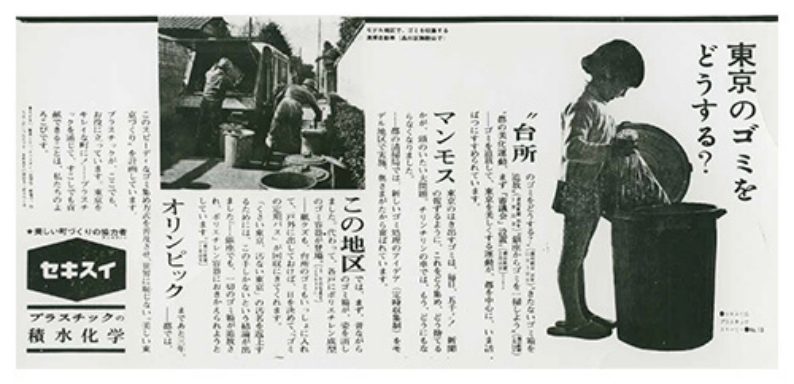
The advertisement series for the "Clean Up Our Streets" movement won the grand prize in the Nikkei Advertising Awards C Category (18 industries, including chemical, electronic, etc.) in 1963.
-
1963
Production of SEKISUI Bath, the first FRP (fiber-reinforced plastic) bathtub manufactured in Japan, begins
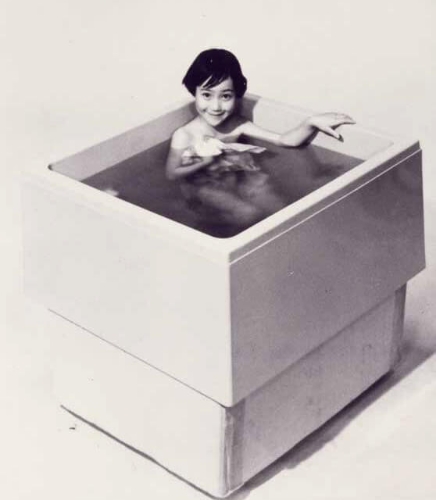
SEKISUI PLASTICS CORPORATION (SPC) opened in Pennsylvania, U.S., for the manufacture of expandable polystyrene paper, the first plant to be set up in the U.S. by a Japanese manufacturer
Tips_1963-
History of Sporting Activity
We’ve thrived in sporting activities for much of our history. Our rowing club won in the Japan Business Sporting Four in 1960, and our table tennis club won in Business Championships in 1962, 1963, and 1965.
Our baseball club won the 1963 Intercity Baseball Championship representing Kyoto. Our ladies’ basketball club rose to number one in the Japan League in 1993, our track and field club (men) began in 1994 (until 2002), and our female athletic group began in 1997. In the same year, Hiromi Suzuki won the world title in the women’s marathon at the World Championships in Athens, and in 2000, Naoko Takahashi won the gold medal in the Women’s Marathon at the 2000 Summer Olympic Games in Sydney.
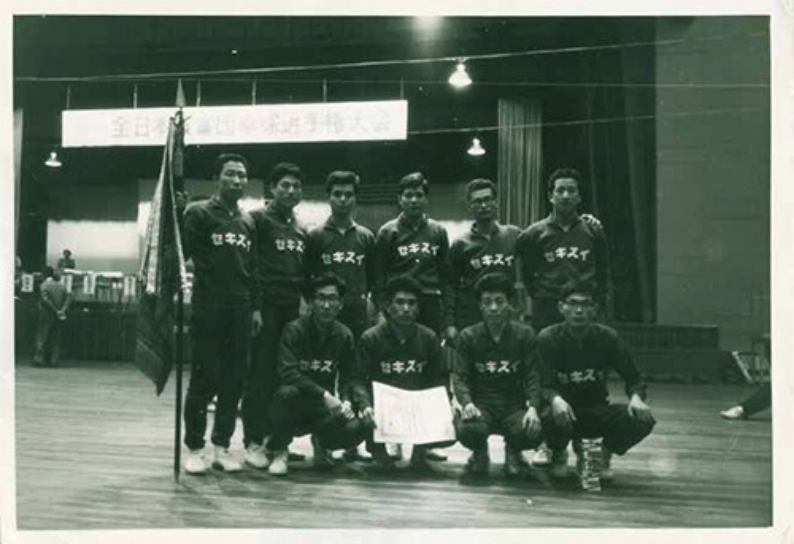
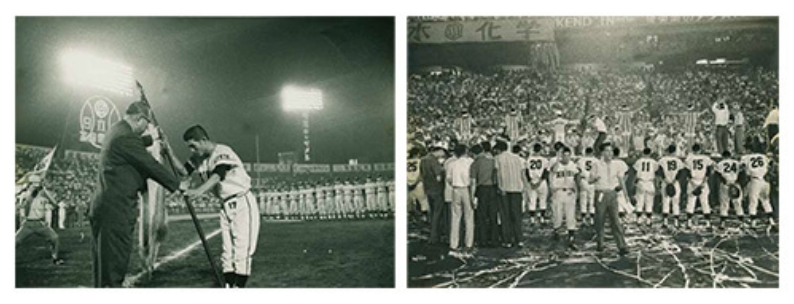
Tips_1963
First Japanese manufacturing company to expand to the U.S.
In 1963, SEKISUI CHEMICAL established SEKISUI PLASTICS CORPORATION (SPC) in Pennsylvania, U.S., to manufacture expandable polystyrene paper. This was the first expansion into the U.S. for a Japanese manufacturing company. In the same year, SEKISUI MALAYSIA CO., LTD. was established in Singapore to manufacture pipes for tin -- mine and general water supply, and SEKISUI continued to actively expand globally until the later half of the 1970s.
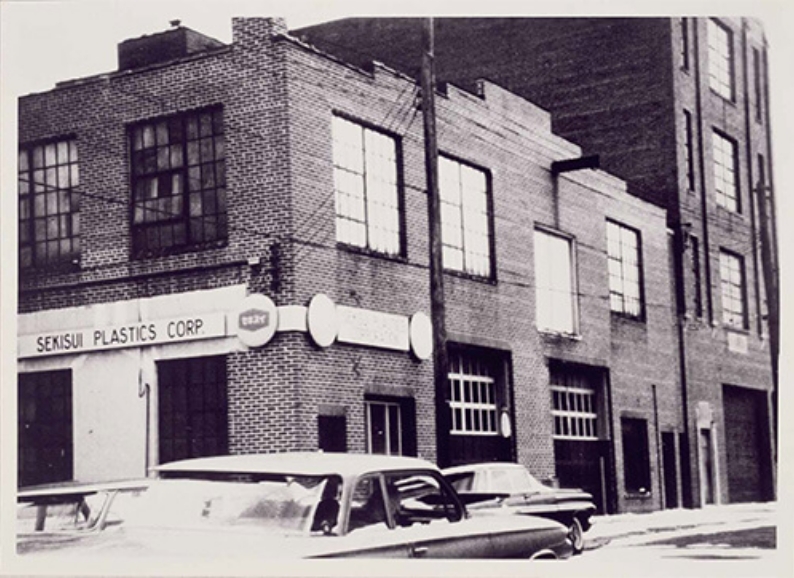
-
1964
TOKUYAMA SEKISUI CO., LTD. is established,
and production of vinyl chloride resin begins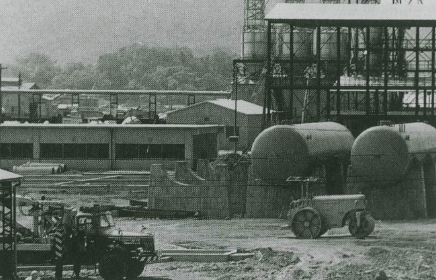
Construction site for TOKUYAMA SEKISUI. Initial capital was 2.5 billion yen. This was a large project, as it amounted to nearly half of our capital at the time (5.7 billion yen)
Tips_1960s
Promoting Domestic Localization
With the economic expansion period coming to an end in 1961 after a long run, performance improvements were widely sought after, such as local product development and transportation cost reduction. This led to the establishment of many local production companies all over Japan from 1962 to 1963, laying the foundation for the various local production companies currently located throughout the country.

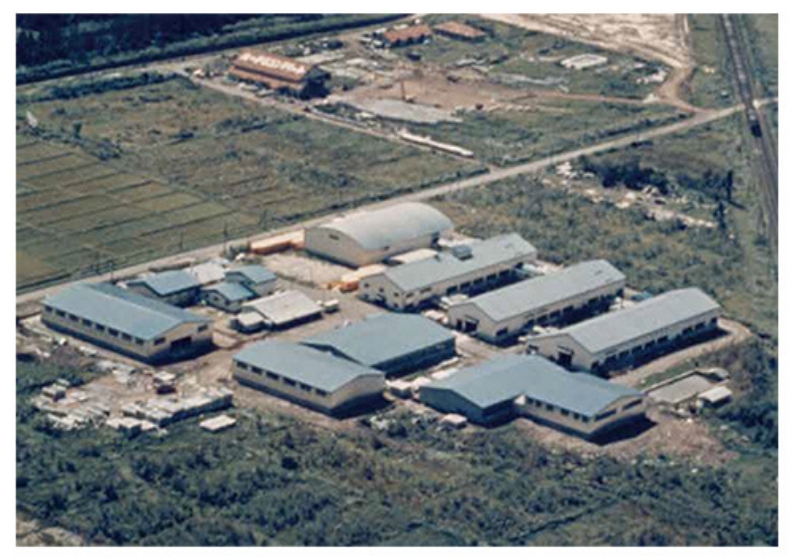
-
1965
The first year of income reductions, deficits, and omitted dividends. In 1967, capital was reduced by half
Tips_1965
Challenges I
Since establishment, business operations have continued to expand, but the burden of interest from excess capital investment and rapid increases put pressure on our operations. In addition, a recession led to poor sales and excessive stock, which in September of 1965 (calculations were only made biannually during that time) led to the first ever income reductions, deficits, and omitted dividends since establishment. In 1967, capital was reduced by half. However, using these challenges as a catalyst, the Softlon business (foam) was started in 1968, and the SEKISUI HEIM modular house was announced in 1970, planting the seeds for a great support even today for the SEKISUI CHEMICAL Group.
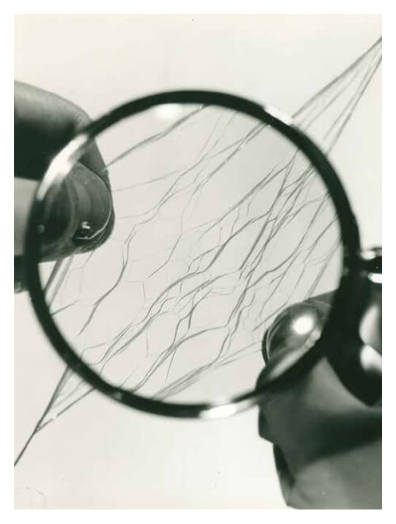
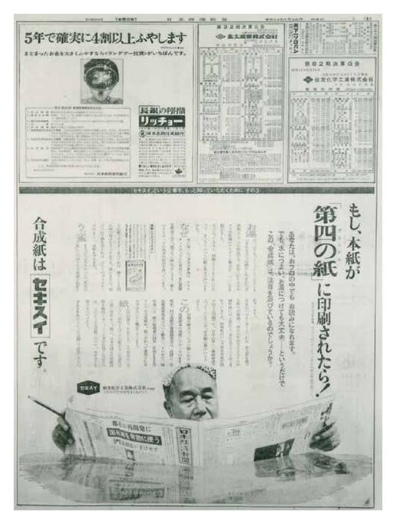
-
1967
The SEKISUI Tento Mushi Matsuri (ladybug festival) was held all over Japan
"It's what I always wanted !" – a common reaction to our many hit products
Firmly established as a symbol of high-quality household plastic in Japan. The Sekisui brand became a solid top brand in household products.
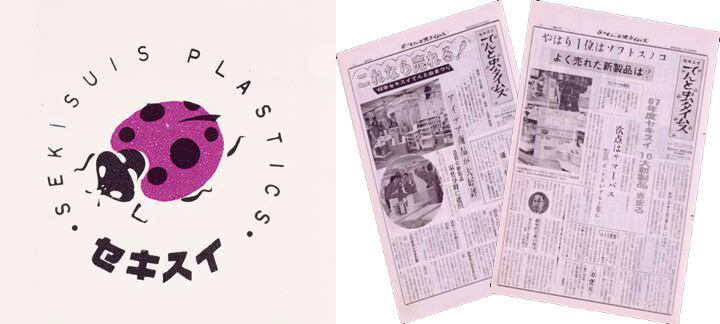
-
1968
Softlon expandable polyolefin business begins, and Sunoko for bathrooms achieved widespread popularity in the late 1960s.
Tips_1968
Active Global Expansion Period I
The Softlon business (foam), started in 1968, received high praises globally, and in 1969 SEKISUI VOLTEK, LLC. was established as a joint venture with an American company. In 1971, SEKISUI ALVEO AG was established in Switzerland, becoming a base for European expansion. SEKISUI S-LEC MEXICO S.A. de C.V. was established in 1971 for the interlayer film for laminated glass business, SEKISUI ESLON B.V. was established in 1974 for the rain gutter business, and other companies were established that support the global expansion goals today of the SEKISUI CHEMICAL Group.
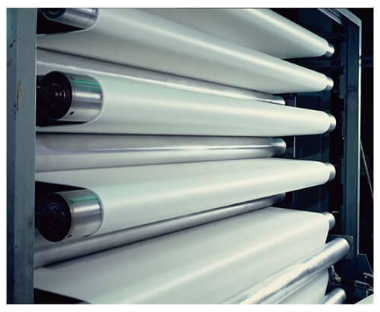
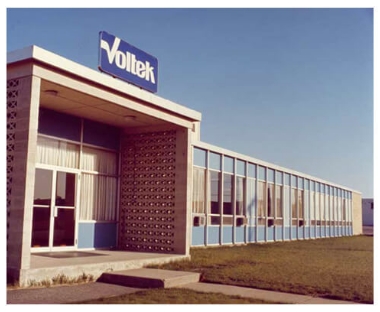

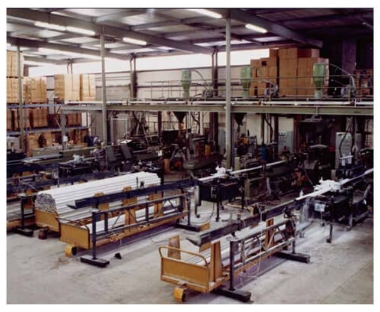
-
1970
Exhibited the SEKISUI HEIM (HEIM M1) modular house at the International Good Living Show in Tokyo
SEKISUI HEIM is born
Development of SEKISUI HEIM M1, the first SEKISUI HEIM product, began in 1970. Through unit production that boasted over 80% production efficiency, SEKISUI HEIM was able to achieve high quality, high functionality, and great cost performance, and immediately performed well in the Japanese housing market, which had rapidly begun to introduce low-cost, high-quality housing. It was first shown at the 1970 International Good Living Show in Tokyo. Sales began the following year, with over 10,000 orders accumulated by 1974. In just 3 years following launch, SEKISUI HEIM joined the ranks of other large prefab house manufacturers.
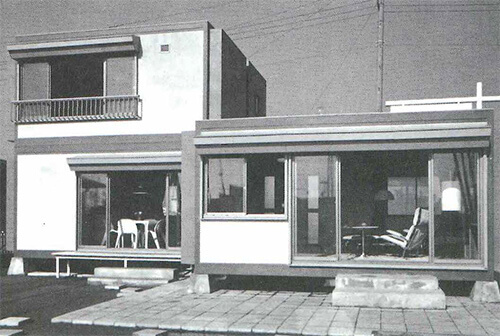
The SEKISUI HEIM that was exhibited at the 1st International Good Living Show in Tokyo. This was an international trade show attended by about 500 companies from 13 countries. HEIM gained a lot of attention as the industrialized housing special exhibition was featured by the media and widely talked about. -
1971
Full-scale entry into housing business with launch of SEKISUI HEIM
First, take aim at the housing demands of the capital! 1st display room in Kanda
Already gaining attention in newspapers and on TV, crowds of customers swarm the display room each day.
The roughly 10 employees working here are said to have gone to heroic lengths to serve all the customers.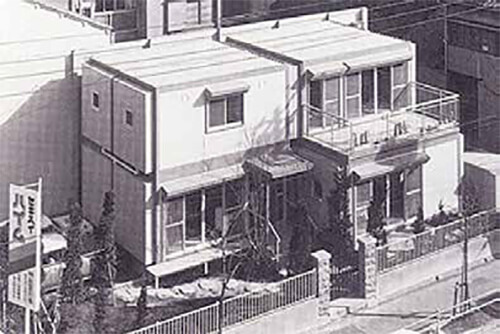
The 1st display room in Kanda, Tokyo, that opened in February of 1971 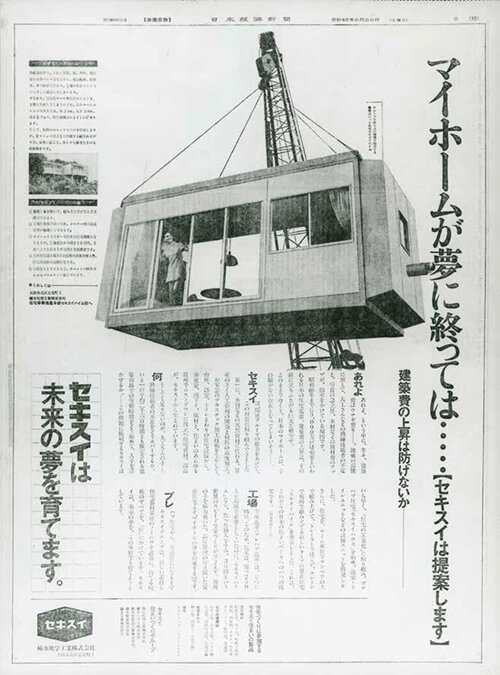
Newspaper advertisement from 1971 -
1972
Headquarters moved to Dojima Kanden building
(the current Osaka headquarters) -
1974
Full-scale production of FFU synthetic wood begins
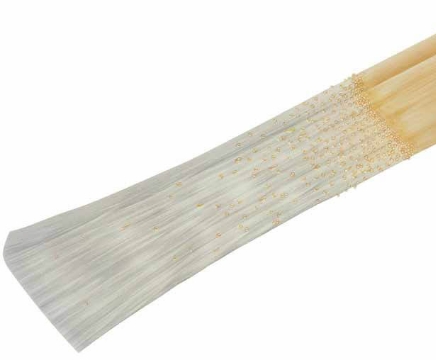
-
1975
Launched ESLON RCP
reinforced plastic composite pipe product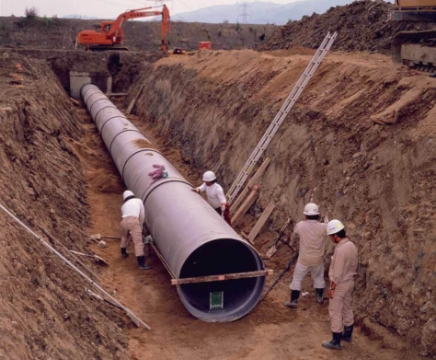
-
1979
Micropearl plastic particles are commercialized
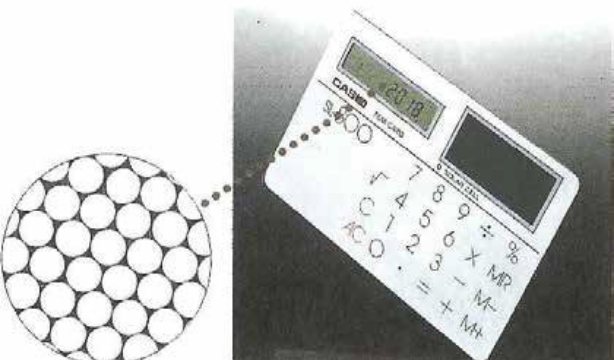
Dicsplayed liquid crystal that used Micropearl S Started medical projects at the Central Research Institute
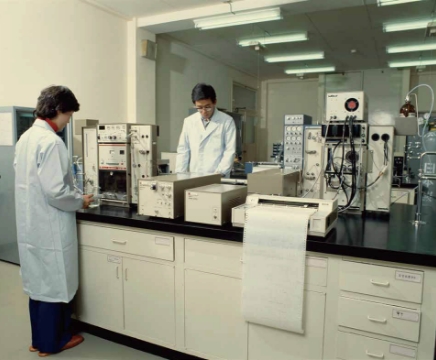
Awarded the Deming Prize, the highest honor for total quality management from production to sales and service
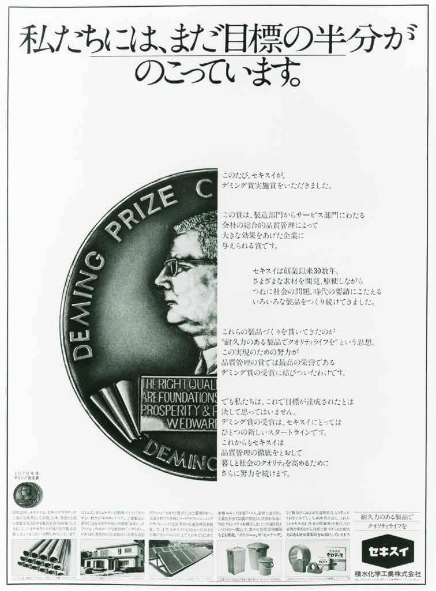
Tips_1970s
There is something strong supporting the World Exposition from underground. That something is ESLON Pipe.
In 1970, the Senri Hills in Osaka hosted the Japan World Exposition among world attention. SEKISUI's ESLON pipe supported the Exposition from underground. All of the water used at the Exposition, including drinking water and plant water systems, was delivered by ESLON pipes. The Exposition was a great success, welcoming approximately 64 million people, and SEKISUI's technology contributed to this success.
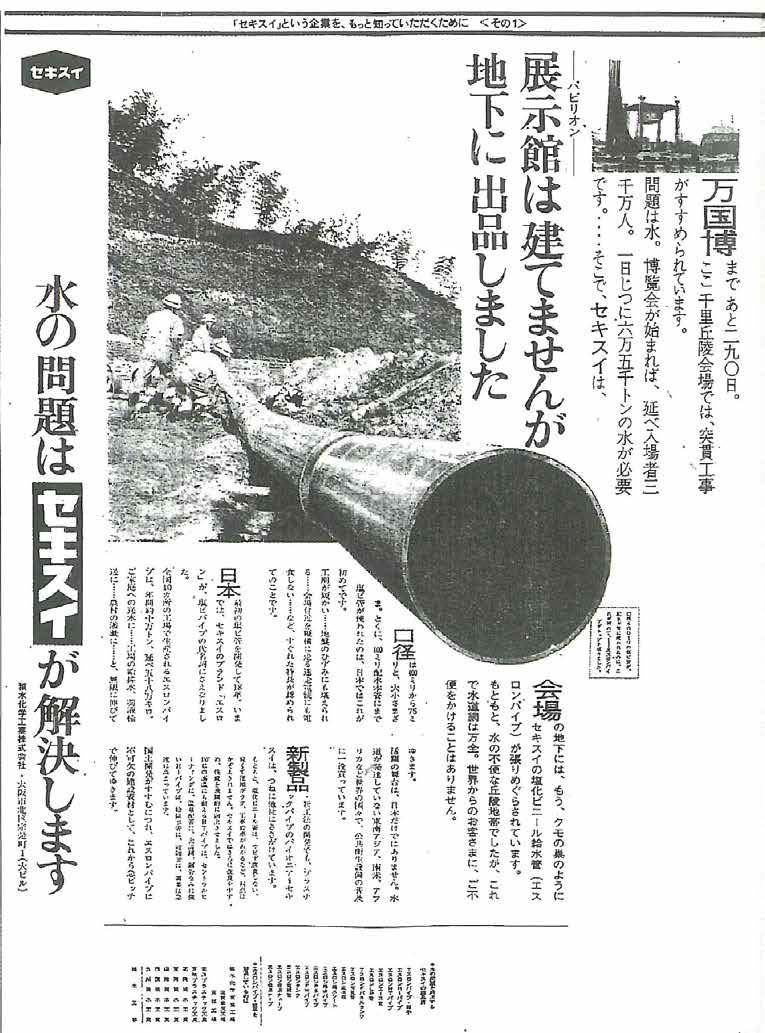
A newspaper advertisement
-
1981
Established a dual-headquarters system, opening a Tokyo headquarters in Toranomon, Tokyo
-
1982
Opened a plant in Gunma
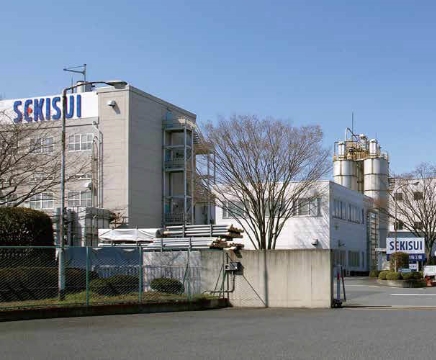
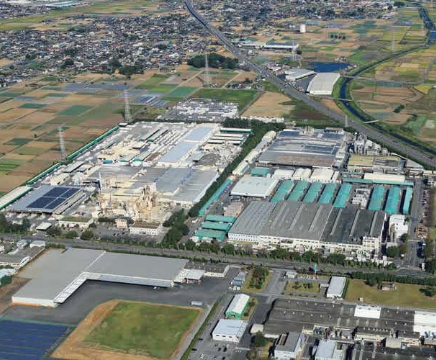
Product launch in Sendai of the Two-U Home, a wooden structured modular house, expanding nationwide from 1984
"Let's make a wooden house! "
This is how the Two-U Home was bornIndustrialized housing incorporating the ideas of Japan. In 1981, East Japan Heim Construction established a new factory capable of producing 150 units per month, starting tangible research aimed at market introduction. The following year, Sendai was chosen as a trial market for the new Two-U Home and trial sales began. Valuable production and implementation information was collected during the approximately 2 years of sales.
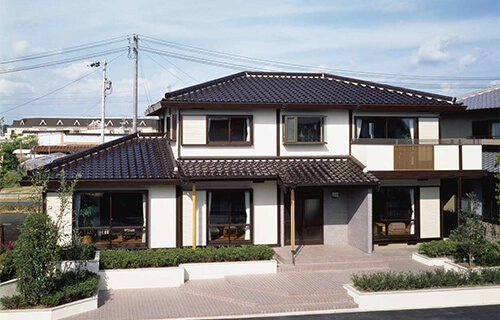
SEKISUI Two-U Home Model A launched in 1982 -
1985
Product launch of the world's first plastic vacuum blood collection tubes
The world's first plastic vacuum blood collection tubes, Insepack
Insepack, plastic vacuum blood collection tubes that won't break even when dropped.
They gained attention as a way of preventing hospital infection, too.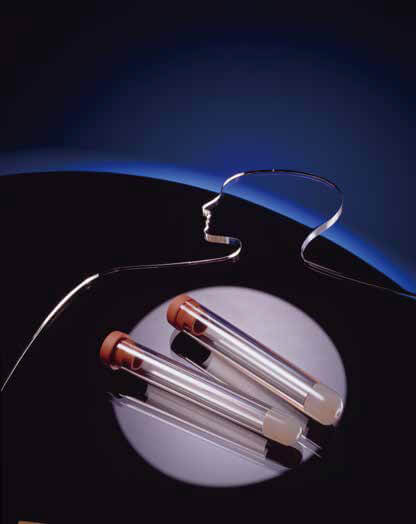
-
1986
Developed the "SPR method", pipe rehabilitation method
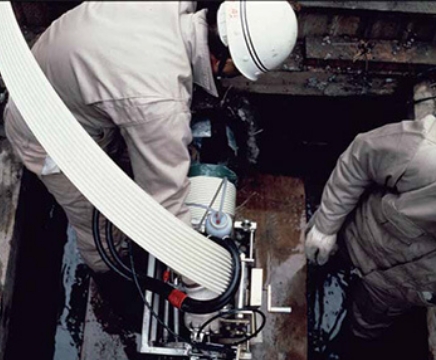
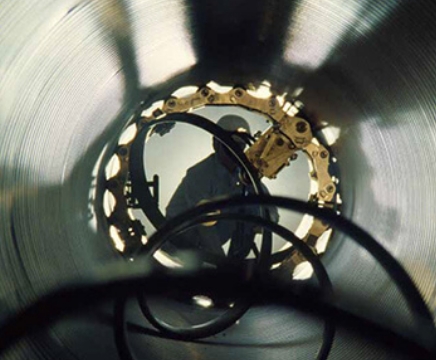
Introduced manufacturing technology from Liblock Systems in the Netherlands, completed as the SPR method. This was an advanced effort in anticipation of infrastructure deterioration in the future.
Tips_1980s
Additional development of lines of business
We established an Applied Electronics Research Institute (now R&D Center) in 1987 for the IT (electronics) field, which has struggled with supplying external parts for electrical appliances since the period of high economic growth. This led us on a journey to strengthen our cutting edge research and development based on accumulated technology.
-
1990
Opened the Housing Integration Institute (now Housing Technology Institute)
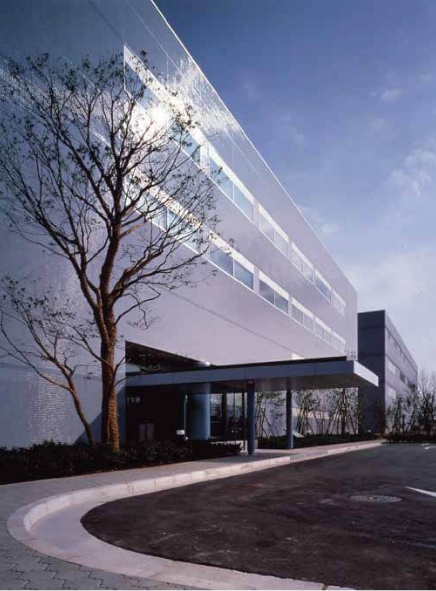
-
1992
Opened the Kyoto Technology Center (now Kyoto Research & Development Institute)
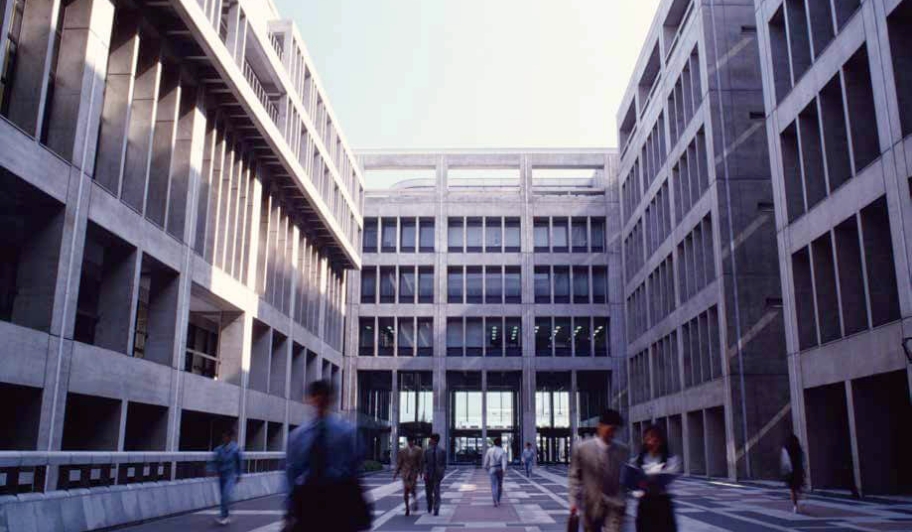
-
1995
Product launch of Desio, a 3-story house launched as a memorial product for the housing business’ 25th anniversary
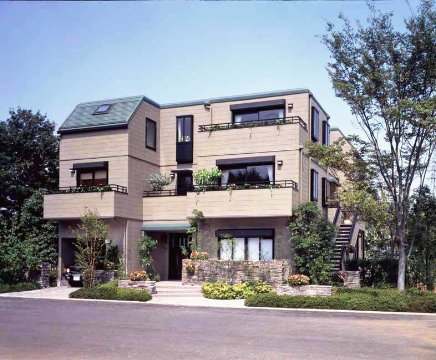
Desio, a 3-story house. Development and production of Japan’s first polyethylene water distribution pipes begins
-
1996
The home refurbishing business (Fami S) begins full commercial operations
The company's capital exceeds 100 billion yen (the current capital)
A new corporate logo established
Tips_1996
A new corporate logo is born!
In honor of our 50th anniversary, we renewed our English logo in 1997. The new logo offers a softer impression than our previous one, and it expresses the attitude of creating kinder products by people in a natural environment – one of our goals. The red circle contained in the letter E represents the idea of aiming for a more prosperous coexistence, matching with our slogan of “living together”.
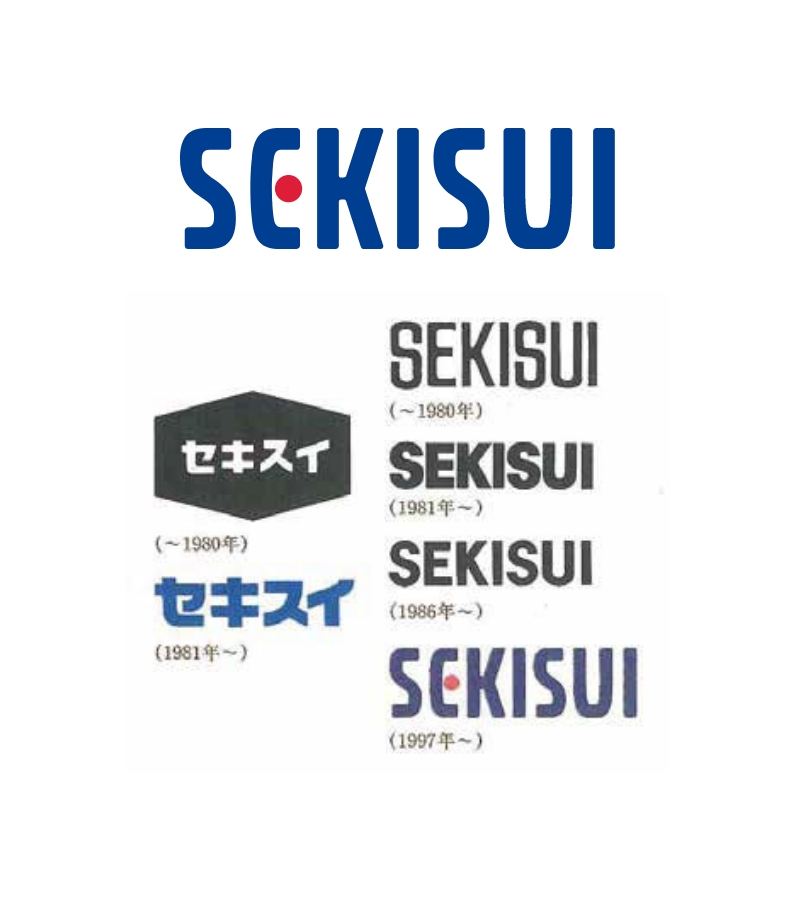
-
1997
Product launch of homes equipped with photovoltaic systems
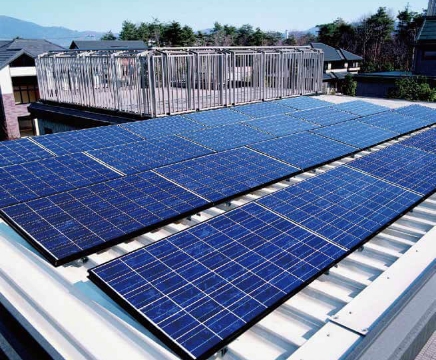
Homes equipped with photovoltaic systems Female Athletics Group established (SEKISUI Fairies, 2012 – )
-
2000
Naoko Takahashi (Female Athletics Group) wins the gold medal in the women’s marathon at the 2000 Summer Olympic Games in Sydney (first Japanese female to win in track and field)
-
2001
Product launch of Fi-Block, a thermal expansion fire protection material
Company Division organization implemented
Tips_1998-2001
Challenges II
We remember the new challenges around the turn of the century. The housing bubble burst, causing our operating profits of over 60 billion yen in 1996 to fall into the red only 2 years later in 1998. There was then a global IT recession, and both fiscal 2000 and 2001 were in the red. We began our company organization system in 2001, together with urgent management measures. We went about restructuring the company, with a reduction of fixed costs and production scales and implementation of an early retirement system. Through these measures, we sped up business selection and concentration, as well as administrative decision making, leading to operational profits in 2002. Since then, we have continued to move towards new growth.
-
2002
Founded the "SEKISUI CHEMICAL Innovations Inspired by Nature Research Support Program" as part of the 65th anniversary celebrations.
-
2003
SEKISUI HEIM M1 selected as part of the 100 Best Examples of Modern Japanese Architecture
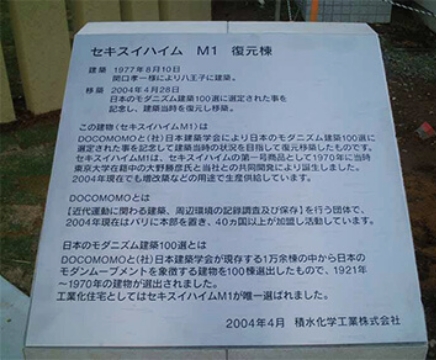
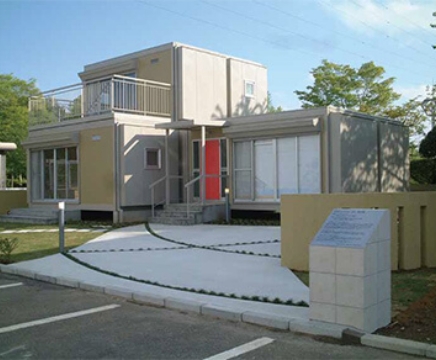
-
2004
Launched in-home care service business (established SEKISUI OASIS)
Tips_2000s
CSR management - Contribute to society through business -
The Creation Research Grant Program for Learning in Nature aims to support research activities of universities and research organizations trying to utilize fundamental scientific knowledge discovered in nature. Established in 2002, it is held each year as one of our 55th anniversary commemorative initiatives.
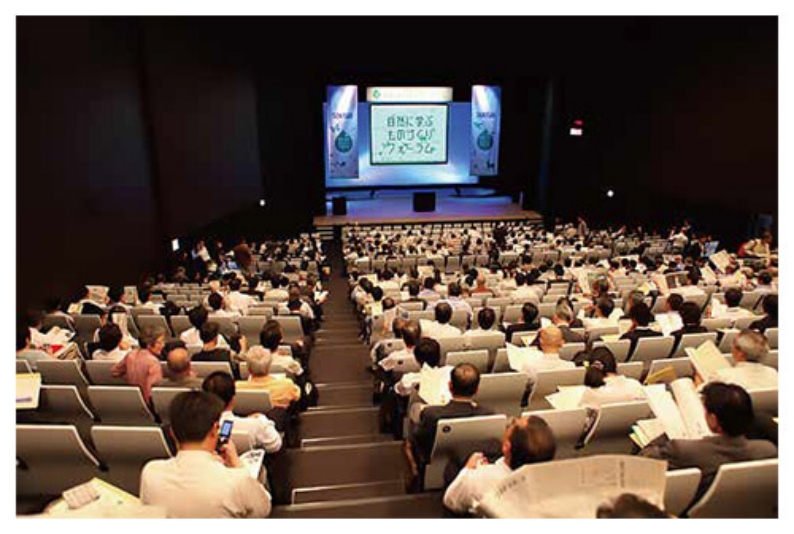
-
2006
Daiichi Pure Chemicals Co., Ltd. Becomes member of SEKISUI CHEMICAL Group aiming to strengthen the medical business
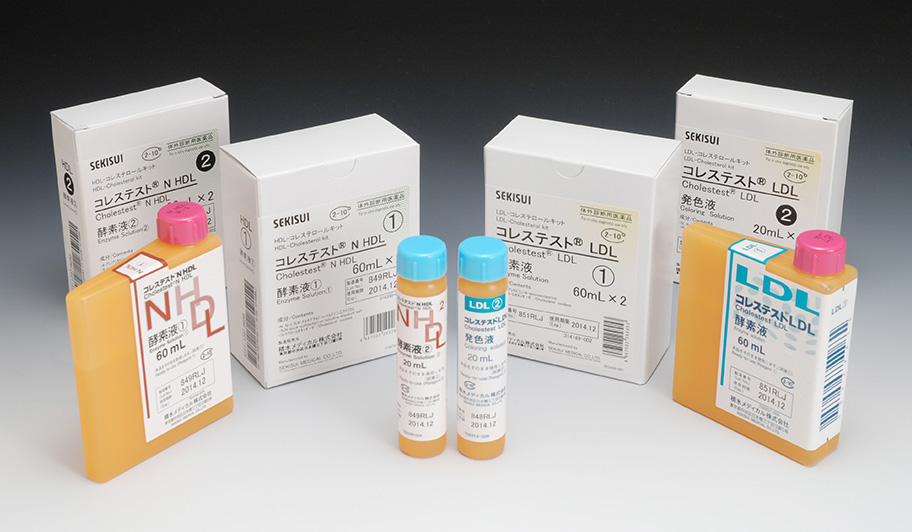
-
2007
Global Children’s Eco Summit, the 60th anniversary program established in 2007
-
2008
New plant opened in Taga
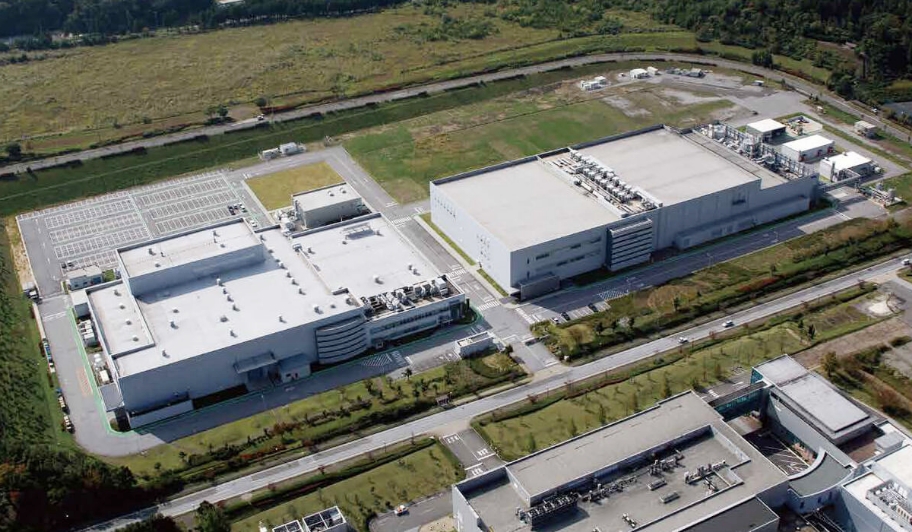
-
2009
Established a joint venture production and sales company in Thailand as the first overseas advancement of the housing business
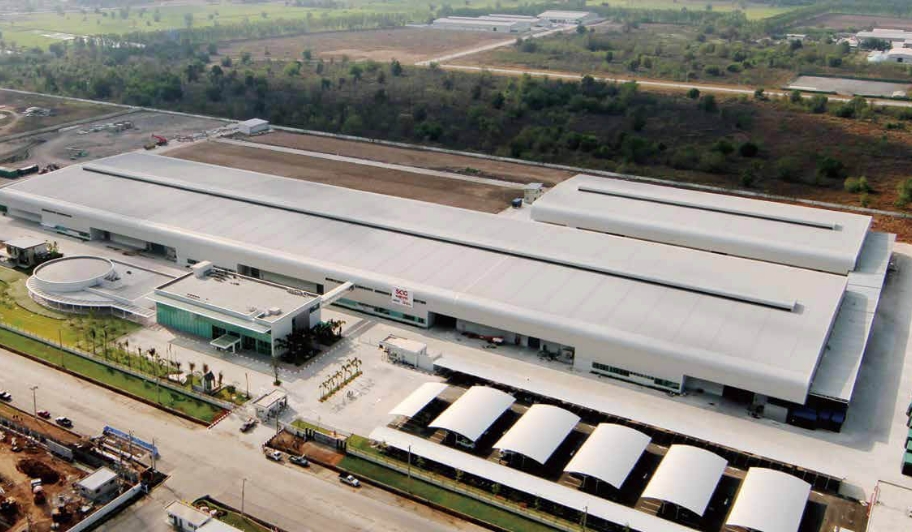
Acquired the polyvinyl alcohol-resin business from the American company, Celanese Corporation, and established SEKISUI SPECIALTY CHEMICALS AMERICA, LLC. and SEKISUI SPECIALTY CHEMICALS EUROPE, S.L.
Tips_2000s
Active Global Expansion Period II
After recovering in 2002, we began planning once again for active global expansion aimed at new growth. A water distribution pipe joint venture company was established in Qingdao, China, in 2002, leading to actual expansion in China, a country with remarkable growth. The following year, bases were also established in China for the interlayer film for laminated glass and medical business (vacuum blood collection tubes). Plants for the interlayer film business were successively put into operation in the Netherlands in 1997, in Thailand in 2002, in China in 2004, and in the U.S. in 2007. For our medical business, we inherited the diagnostic reagent business from Genzyme Corporation (now SEKISUI DIAGNOSTICS, LLC. ) in 2010, and have expanded our business in Europe and America.
-
2011
Production and sales for housing business are integrated into a single system
-
2012
Hosted the Global Children’s Eco Summit as part of the 65th anniversary celebrations. Established the "SEKISUI Environment Week" and the "Greenest Person award" based on children’s ideas
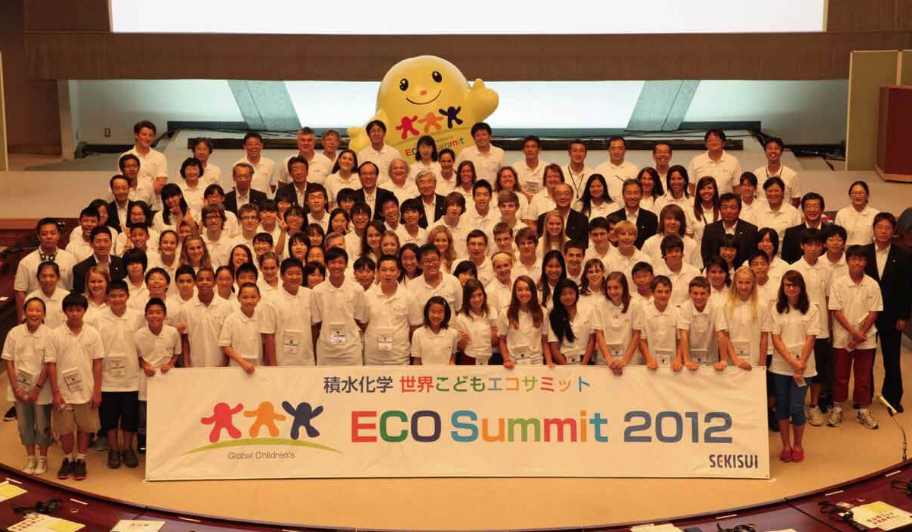
The Global Children’s Eco Summit
Tips_1972-
Environmental Management Progress
Air and water pollution in Japan became a social matter in the 1950s, and we established our Environmental Management Department in 1972, planning out reduced environmental burdens for society through promoting environmental management systems, zero emission activities, etc. Additionally, in 2003, we began evolving into an environmental management organization, striving to think about and develop not only risk management but also the environment as an integral part of management.
In 1993, we introduced a Product Environmental Impact Evaluation system to examine the contribution and care given to the environment in the product development and planning stages. We established the Environmental Contribution Product system in 2003, registering products that demonstrate great positive contributions to the environment for our customers, and this has allowed us to secure both ecology and economy through creating and expanding this system.
1972
Environmental Management Office established
2000
First zero-emissions factories
2003
Environmental Management Promotion Department established
2006
Environmental Contribution Product system implemented
2012
65th anniversary commemoration
Held the World Eco Summit
Established “SEKISUI Environment Week” and “Eco-friendly” system in response to children’s proposals
-
2013
The "SPR method" for pipeline rehabilitation was awarded the Okochi Memorial Prize
-
2015
Development of sound insulation interlayer film for laminated glass awarded the Okochi Memorial Production Prize
Launched full-scale operations at the Chlorinated Poly-Vinyl Chloride (CPVC) resin and compound plants in Thailand
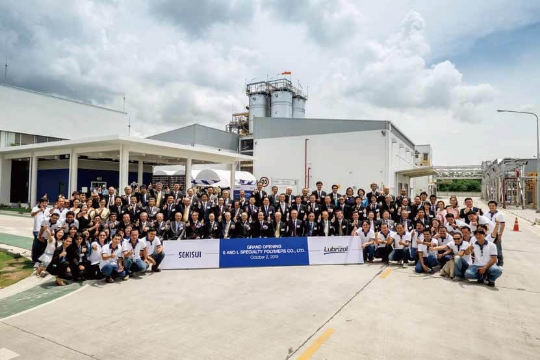
-
2016
Misaki Onishi, a member of the female athletics group (the Sekisui Fairies) competed in the 2016 Summer Olympic Games in Rio de Janeiro
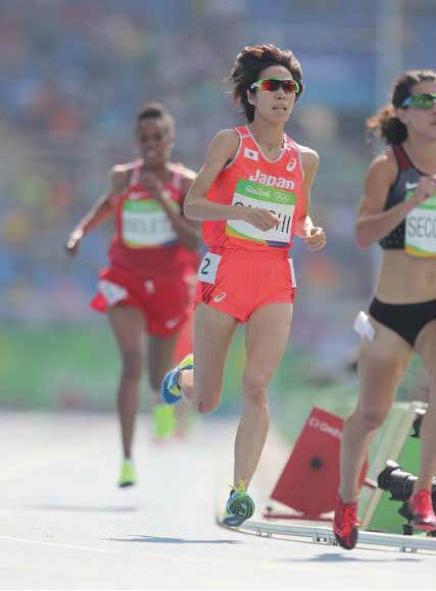
©Rikujyo Kyogi, a monthly publication Advisor Okubo received the Deming Prize
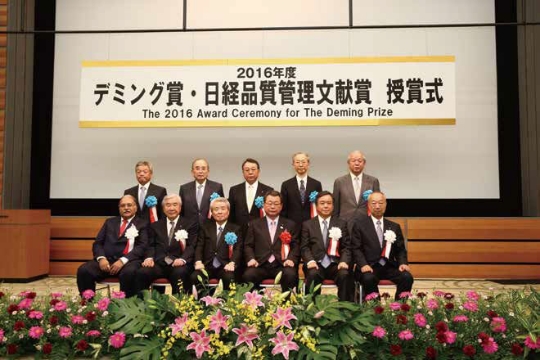
Okubo Advisor at the award ceremony
(front row, 2nd from left) -
2017
70th anniversary
Film type lithium ion battery business started. First product was installed in the "Smart Power Station 100% Edition"
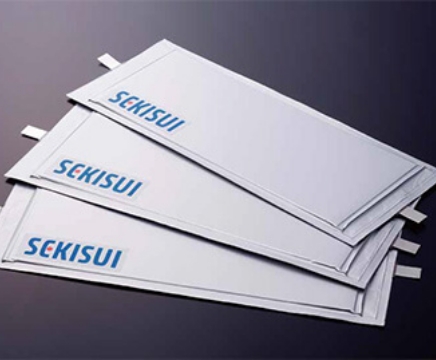

In addition to large-scale development of thin film lithium ion batteries and coating processes, we established a new electrode-coating insulating material and processing technology, offering safety, longevity, and high volume at the same time.
【Film-Type Lithium-Ion Batteries】
Using a coating process, we have developed a large-capacity film-type lithium-ion battery which simultaneously achieves high safety, long service life, and large capacity. Commercialization is taking place with the number one target being the field of stationary and home storage batteries. -
2019
【Complex large-scale town “Asaka Lead Town” of SEKISUI CHEMICAL Group's Urban Development】
Opened a complex large-scale town that used 102 products and services of SEKISUI CHEMICAL Group. We concentrated the total power of the group to contribute for the solution of regional and social problems under the motto "Safe & Sound: a sustainable eco-friendly town"(Images are for illustration purposes.)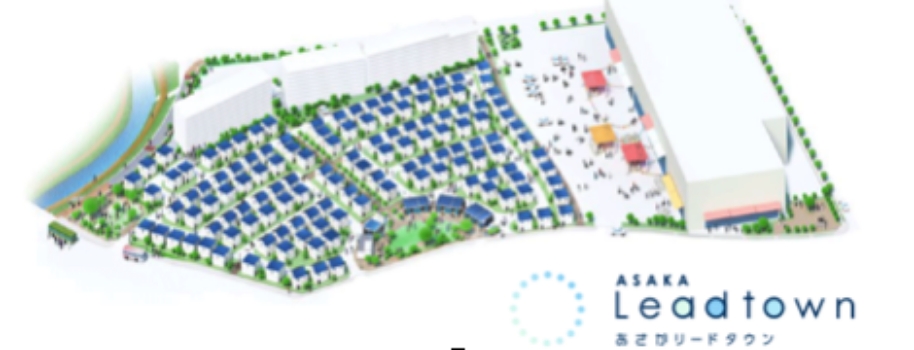
Ground
Housing
-
- Energy-saving house
-
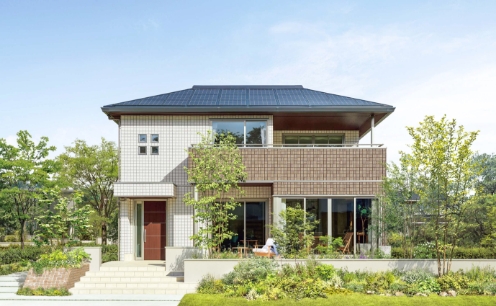
SMART HEIM
-
- Wooden-frame modular house
-
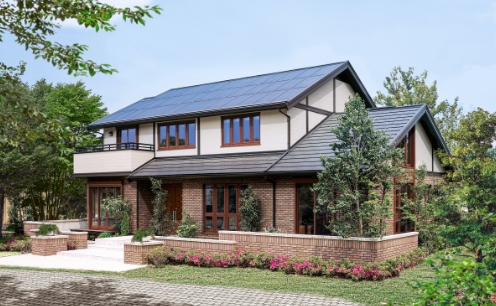
GRAND TO YOU
-
- Secure Drinking Water
During Disasters -
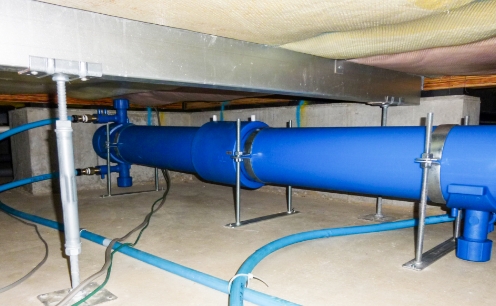
Drinking Water System
- Secure Drinking Water
Road Park Facility
-
- Shade The Tree
With The Power Of Chemistry -
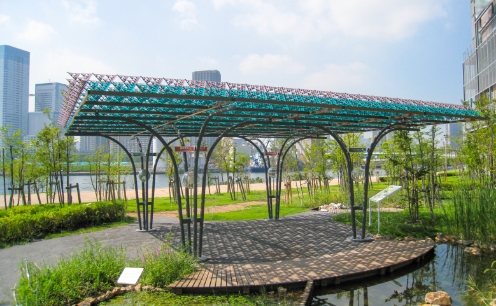
Airy Shade
- Shade The Tree
-
- Toilet That Can Be Used
Hygienically In Case Of Disaster -
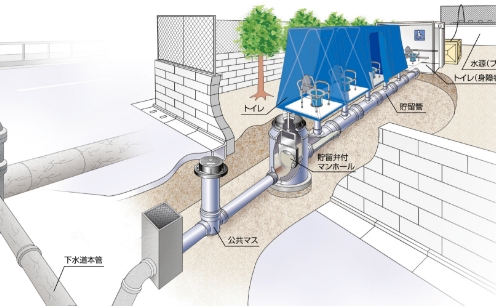
Disaster Manhole Toilet
- Toilet That Can Be Used
Underground
Water
-
- Water Supply With Excellent
Earthquake Resistance -
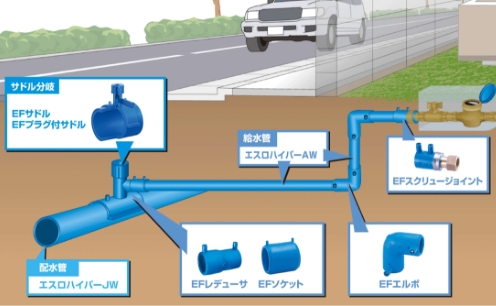
Housing
- Water Supply With Excellent
-
- Temporarily Store Rainwater
And Control Runoff -
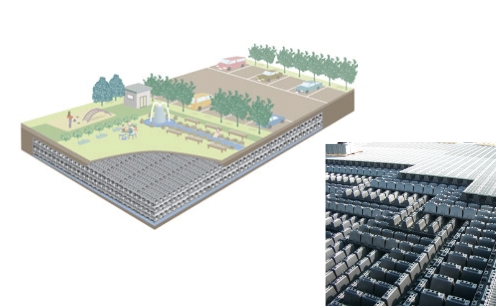
Cross-Wave
- Temporarily Store Rainwater
Energy Equipment
-
- Underground Wires
-
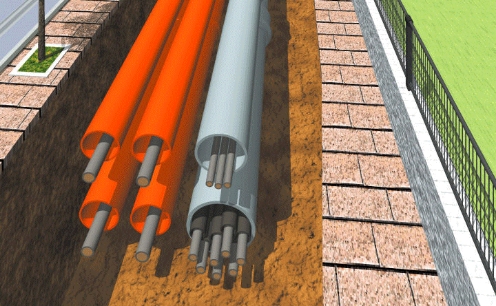
CC=BOX
-
- Gas Supply With Excellent Earthquake Resistance And Durability
-
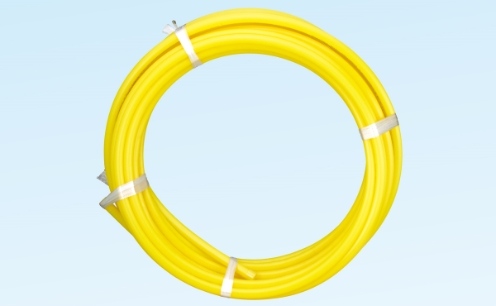
Polyethylene Pipe For Gas
Tokyo Head Office relocated to current Okura Prestige Tower
-
-
2020
Long-term Vision ”Vision 2030” (for FY2020 to FY2030)
-
2021
Women's Track & Field Team SEKISUI Fairies Wins First Queen's Ekiden
-
2022
75th anniversary










